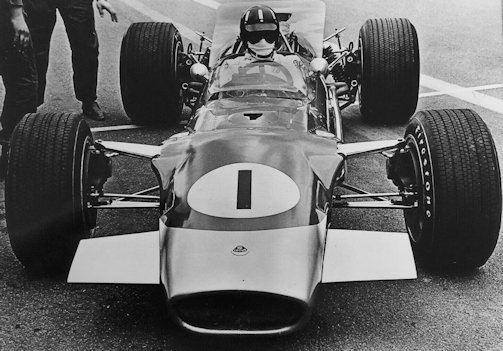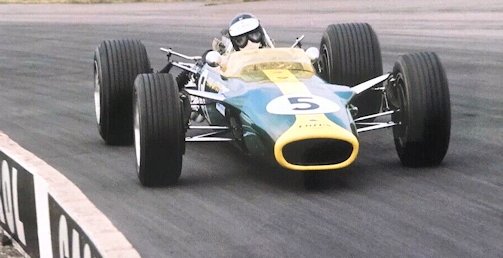Lotus 49 Grand Prix Race Car
 |
|
|
Constructor: |
Lotus |
|
Class |
Race Car |
|
Years |
1967 to 1968 |
|
Designer: |
Colin Chapman |
|
Engine: |
Cosworth FVA |
The Lotus 49 was a Grand Prix racing car, built and used by Lotus in the late 1960s.
History
The long-awaited Cosworth-powered V-8 Grand Prix car, which made its debut at Zandvoort in 1967. Although not without its teething troubles, the car soon proved itself.
The monocoque aluminium-alloy sheet chassis, with which the engine was composite, had front suspension by upper rocking levers and lower wishbone members and rear suspension by upper transverse links and lower wishbones, with coil spring/damper units front and rear. V-8 Cosworth engine of 2993 cc (85.7 x 64.8 mm) with four overhead camshafts, four valves per cylinder, Lucas port fuel injection and a power output of 400 bhp at 9000 rpm. The Transmission by ZF 5-speed and reverse gearbox in unit with the final drive which incorporated sliding roller splines in the differential.
Lotus team boss Colin Chapman brought in 1966, the two Ford technicians Haley Coop and Walter Hayes with Keith Duckworth of Cosworth together with the aim of developing a new engine for the F1. Ford intensively supported the development of the DFV (Double Four Valve) and Lotus, with an exclusive contract for use, cut the Lotus 49 to this engine.
He was an uncomplicated car with timeless lines. The 90-degree V8 engine determined the cross section of the monocoque. He was so attached behind the cockpit that he played a major role. The subframe of the rear suspension was bolted to the engine block and cylinder heads. It was expensive to change the engines, but the car had a good centre of gravity. The drivers raved about the 49, which was light and manoeuvrable and whose engine had a wide rev range.
Lotus built twelve chassis with the designation 49 (three of which were conversions of the already existing, but received a new hull number). One or the car remained an exhibit and was never driven, the other eleven were used under the Evo designations from B to T until the early 1970s. The T with a just 2.5-liter Cosworth V8 was driven only in the Tasman series (hence the T), a racing series in Oceania that was very popular in the late 1960s.

The 1968 Lotus 49B had a longer wheelbase that allowed wider wheels from this season, a slightly more wedge-shaped body and modified subframes. In order to improve the grip, the front was first provided with short wings at the rear of a tear-off edge.
In 1969, front and rear oversized wings were used, which were mounted on high supports with rubber elements directly to the steering knuckles and not as in the competition on the vehicle frame. The output forces should not act on the entire car, but only on the wheels. However, the front wing soon proved to be detrimental as the supports bent and the tires touched. At the Spanish Grand Prix, the front wings were again replaced by wing stubs on both sides of the front hood. In the race, the rear wings buckled and finally failed completely. At first, Graham Hill crashed behind a high-speed jump but was uninjured. Three laps later Jochen Rindt crashed at this point for the same reason. He hit the wreck of Hill's car and was only recovered from the bent chassis with a broken nose. After these serious accidents in Barcelona, the rear wing was dismantled. For during the training for the Grand Prix of Monaco in 1969, the Commission Sportive Internationale (CSI) finally banned all wings. From now on, stabilizing surfaces were only allowed on the sprung part of the chassis. Shortly thereafter, the regulation was clarified: rear wing maximum 800 mm high and maximum 1100 mm wide.
The Lotus 49C, which was still occasionally used in 1970, received the three-piece rear wing of the Lotus 72.
The 49B was the 1968 wedge-shaped car which appeared at Monaco and this featured an increased wheelbase by angling forward the upper rocker arms, modified rear suspension and a Hewland gearbox.
In 1969 Lotus continued to rely on the 49B and also raced the 63 four-wheel-drive car. Jochen Rindt now joined Graham Hill in the Gold Leaf Team and while Rindt's driving was fast, furious and usually ended in retirement, Hill seemed off-form all season and at the end of the year crashed badly in the United States race. As in 1968, Jo Siffert raced a car for Rob Walker. Because of aero-foil failures both Hill and Rindt crashed in the Spanish race at Barcelona and Dickie Attwood was brought in to replace the injured Rindt at Monaco only. At the beginning of the year Hill and Rindt drove 49T cars with 2500 cc engines in the Tasman races.

Although work was proceeding on the new 72 Grand Prix car for 1970, before it was ready to race and while it was being sorted out after an unsuccessful début, Lotus
continued to field the 49 cars, now in 'C' form with modified front suspension, 13-inch front wheels and new hubs. Rindt was now partnered in the team by John Miles (who had driven one of the 63 cars in 1969), Graham Hill appeared at the wheel of Rob Walker's 49C pending delivery of a 72 late in the season and American driver Pete Lovely fielded a 49B in some races. At Monaco the 49Cs had three-tier rear aerofoils of the type designed for use with the 72. This was to all intents and purposes the
last serious outing of a 49 under the works banner, but a car was entered at a few races under the name of World-Wide Racing (a Lotus subsidiary) for Spaniard Alex Soler-Roig, cars were fielded at the 1970 British and German races for Emerson Fittipaldi, Wilson Fittipaldi drove a works 49C in the 1971 Argentine Grand Prix and Tony Trimmer appeared with one of these cars at the 1971 Rothmans Trophy race at Oulton Park.
The 49 was driven by the great champions of its era. Already at the first appearance in 1967 at the Grand Prix of the Netherlands Jim Clark celebrated with it the victory. It was also the first victory for the Cosworth V8 engine at the first start. His final victory in 1968 in South Africa Jim Clark scored in a 49th For four years, the Lotus 49 was the measure of things in the Formula 1 Twelve times won drivers with these race cars in World Championship races.
Graham Hill became world champion in the 49er for the second time in his career in 1968 and, after 1963 and 1965, brought Lotus the third title of Constructor World Champion. The Lotus 49 was also the last vehicle to win a Grand Prix by a true privateer. Jo Siffert won in 1968 for Rob Walker the Grand Prix of Great Britain in Brands Hatch.
The last success for this legendary racing car entered Jochen Rindt in 1970. Rindt, who was reluctant to drive the new Lotus 72, once again hit 49 on the Monaco Grand Prix, narrowly winning after Brabham braked in the last lap of the Rascasse.
Race Successes
1967:
1st (Clark), Dutch Grand Prix; 1st (Clark), British GP; 3rd (Clark), Italian GP; 1st (Clark), 2nd (Hill), United States GP; 1st (Clark), Mexican GP
1968:
1st (Clark), 2nd (Hill), South African GP; 1st (Hill), Spanish GP The 49T was the Tasman version of the 49, with the Cosworth engine reduced to 2 litres (85.67 x 54.10
mm). Clark scored four wins with this car in the 1968 series.
1st (Hill), Monaco GP; 1st (Siffen), British GP; 2nd (Hill), German GP; 2nd (Hill), United States GP; 1st (Hill), 3rd (Oliver), Mexican GP.
Lotus won the 1968 Manufacturers' Championship
1969:
2nd, (Rindt), New Zealand GP; 1st, (Rind), 2nd, (Hill), Lady Wigram Trophy race; 1st, (Rindt). Warwick Farm 100 race; 2nd, (Rindt), Sandown Park race; 2nd, (Hill), South African GP; 2nd, (Hill), Race of Champions; 2nd, (Rindt), Daily Express Trophy race; 1st, (Hill), 3rd, (Siffert), Monaco GP; 2nd, (Siffert), Dutch GP; 2nd, (Rindt), Italian GP; 3rd, (Rindt), Canadian GP; 1st, (Rind), United States GP.
1970:
2nd, (Rindt), 1st, (Rindt), Race of Champions; Monaco GP.
Technical
-
Lotus 49 Technical details and specifications (1967-1969)
ENGINE:
Ford-Cosworth V-8
Capacity: 2,993cc
Bore & Stroke: 85.6 x 64.8mm
four valves per cylinder
two ohcs per bank
430bhp at 9,000rpm
Lucas port fuel injectionTRANSMISSION DRIVE LINE:
Gears: ZF gearbox 5-speed and reverse gearboxCHASSIS:
aluminium-alloy sheet chassis forward monocoque, stressed engine.
Independent front suspension with inboard coil springs.upper rocking levers and lower wishbone member
Independent rear suspension upper transverse links and lower wishbones, with coil spring/damperBRAKES:
discChanges By Model and Year
Stage of development:
49 (1967)
Engine:
Ford Cosworth V8 (90 °)
Displacement:
2995 cc
Bore × stroke:
85.74 x 64.77 mm
Power at 1 / min:
about 300 kW (410 hp)
at 9000Compression:
11: 1
Valve control:
two overhead camshafts per cylinder row,
driven by gearsCooling:
water
Transmission:
ZF 5DS-12
(fully synchronized)Front suspension:
Double wishbones (different lengths),
internal coil springs with dampers, anti-roll barRear suspension:
Double wishbones (different lengths),
thrust struts up and down, coil springs and dampersChassis and construction:
Monocoque from Alclad , engine / gearbox as a structural component flanged
auxiliary frame front (wings, water cooler)Track front / rear:
1524/1549 mm
Wheelbase:
2413 mm
Bikes:
15 "Lotus Magnesium
Length of the car:
4013 mm
Dry weight:
500 kg
Start Weight:
709 kg
Stage of development:
49B (1968)
Engine:
Ford Cosworth V8 (90 °)
Displacement:
2995 cc
Bore × stroke:
85.74 x 64.77 mm
Power at 1 / min:
about 305 kW (415 hp)
at 9500Compression:
11: 1
Valve control:
two overhead camshafts per cylinder row,
driven by gearsCooling:
water
Transmission:
Hewland FG400
or DG300Front suspension:
Double wishbones (different lengths),
internal coil springs with dampers, anti-roll barRear suspension:
Double wishbones (different lengths),
thrust struts up and down, coil springs and dampersChassis and construction:
Monocoque from Alclad , engine / gearbox as a structural component flanged
auxiliary frame front (wings, water cooler)Track front / rear:
1590/1549
Wheelbase:
2489 mm
Bikes:
15 "Lotus Magnesium
Length of the car:
4013 mm
Dry weight:
535 kg
Start Weight:
744 kg
Stage of development:
49B (1969)
Engine:
Ford Cosworth V8 (90 °)
Displacement:
2995 cc
Bore × stroke:
85.74 x 64.77 mm
Power at 1 / min:
approximately 315 kW (430 hp)
at 10 000Compression:
11: 1
Valve control:
two overhead camshafts per cylinder row,
driven by gearsCooling:
water
Transmission:
Hewland DG300
Front suspension:
Double wishbones (different lengths),
internal coil springs with dampers, anti-roll barRear suspension:
Double wishbones (different lengths),
thrust struts up and down, coil springs and dampersChassis and construction:
Monocoque from Alclad , engine / gearbox as a structural component flanged
auxiliary frame front (wings, water cooler)Track front / rear:
1590/1549
Wheelbase:
2489 mm
Bikes:
15 "Lotus Magnesium
Length of the car:
4013 mm
Dry weight:
540 kg
Start Weight:
744 kg
© Motor car History
